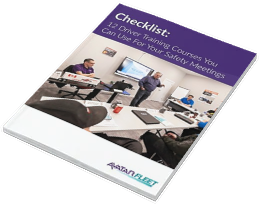At AvatarFleet, we love safe drivers. That’s why we always have our ear to the ground when it comes to accident data. It’s also why we hate to see FMCSA reports like this one. Among the many unsettling figures in this report are two enormous ones: crash injuries have gone up by 22,000 in a single year and over 600 truck drivers were in fatal crashes. We work every day to reduce these numbers. We want other people to start doing the same.
What is the Source of Your Terminal’s Risk?
Never forget that all accidents are caused by the choices people make. If the weather is bad, you can choose to ignore the unsafe conditions or you can choose to leave more room and drive slower. If your truck is in need of repair, you can choose to rush to the customer or sacrifice a few dollars in the name of returning home safely. No one plans to have an accident, but when we behave in unsafe ways, we cause them. The good news is that means they’re preventable by reducing risky and unsafe behaviors.
When you want to reduce accidents, it helps to put them into categories. This FMSCA report does just that. For example, this report lists 61% of all accidents as occurring in rural areas. When we start to unpack why these areas were likely less lit at night and had narrower lanes than an interstate. But the rural road didn’t have the accidents, people had the accidents.
Safety managers need to review their own accident reports closely. If you have a driver that gets into one accident a year, Heinrichs Law states that he escaped completing the same unsafe behavior 300 times without any negative consequences. We need to observe the things that cause most of these accidents. Find out what’s been involved in accidents at your terminal. Maybe you need to crack down on phone usage behind the wheel. Maybe drivers need to be reminded not to speed when they are late on a run. Whatever the source of these accidents, it’s crucial that you identify the problems before you can enact the proper solutions. Many of you already have a gold mine of data with in-cab cameras to identify the top risky behaviors.
How to Leverage a Safety Culture and Reduce Your Risk
One accident is still too many. Zero accidents is the only acceptable goal. Your drivers can always improve their techniques and reduce risky behaviors.
For that reason, it helps immensely to have a behavior-based safety program in place at your company. You can’t create a safe driving culture without starting at the beginning. You need to hire drivers who want to be safe and want to avoid risk. On the other hand, your veterans might become complacent over the years. Safe behaviors are learned through practice and you have to force them to practice.
Safety is a never-ending process. You need continuous campaigns to keep safety top of mind, every day. LLLC Certification is a good place to start. Thanks to technology, online video training is now accessible on their phones. Even better, LLLC allows the best of the best to become instructors of these principles to teach new drivers that come after them. A combination of online learning, classroom, and peer behind-the-wheel evaluations is the complete package for a proper safety campaign.
Get Busy With A Safe Driver Campaign
It helps to talk about the risks your terminal faces if you want something to change with drivers, but no one will drive safer on their own. We have to get busy teaching them how. Focus on the behaviors that will impact your most common losses and create a campaign around 80% of your recurring issues. An effective safety program doubles as a driver career path, reward them for moving up the safety rankings.
Sign up for our newsletter
Get the latest articles on all things transportation delivered straight to your inbox.
Schedule a live demo

